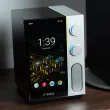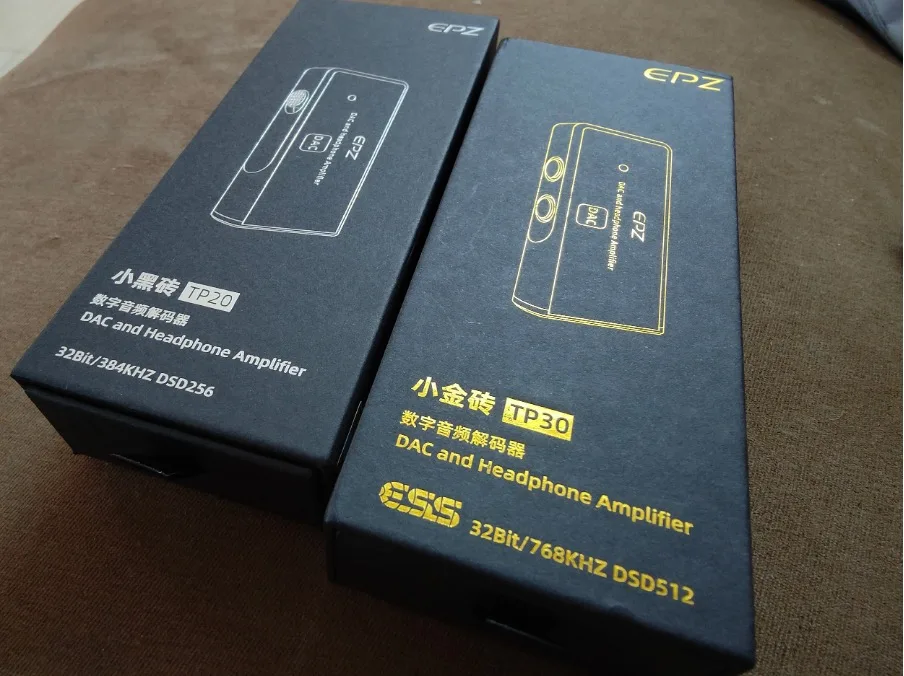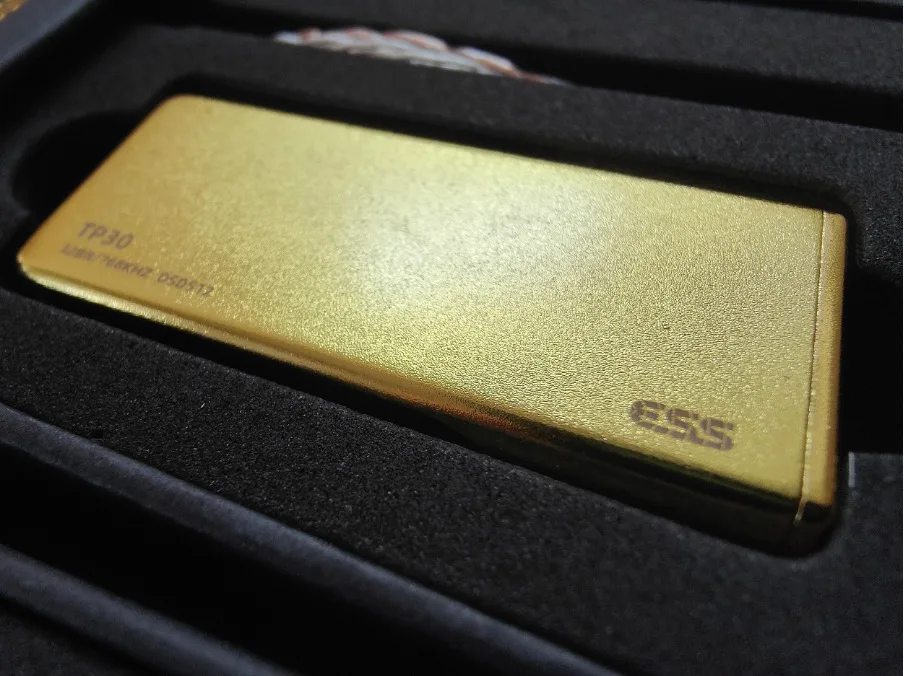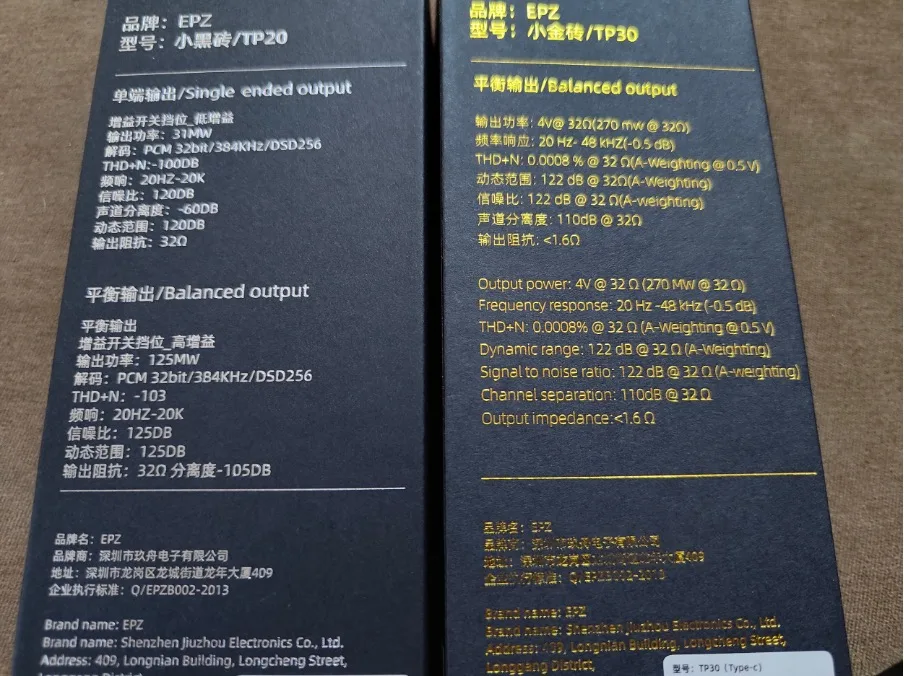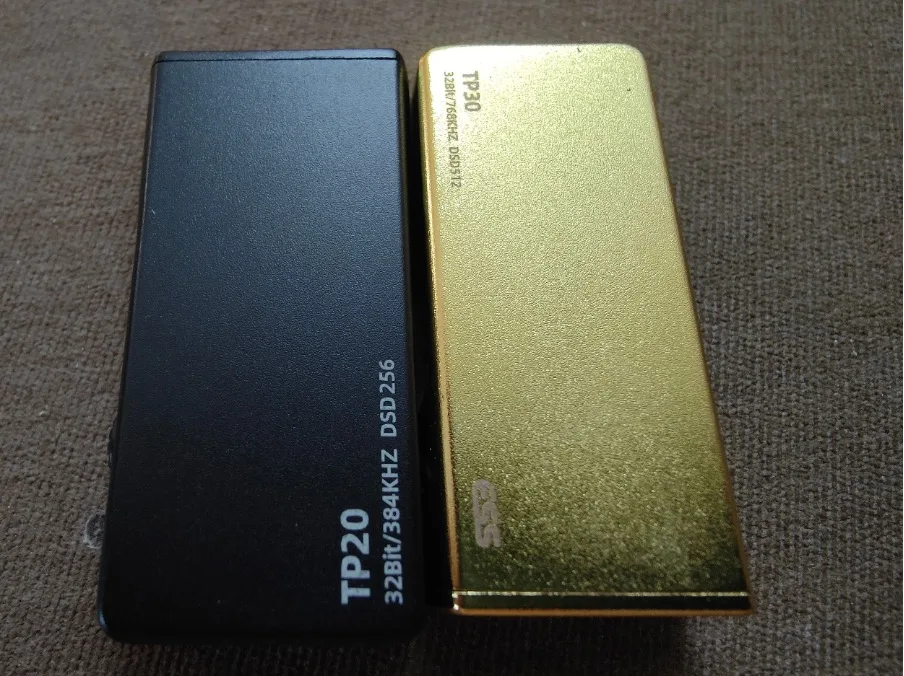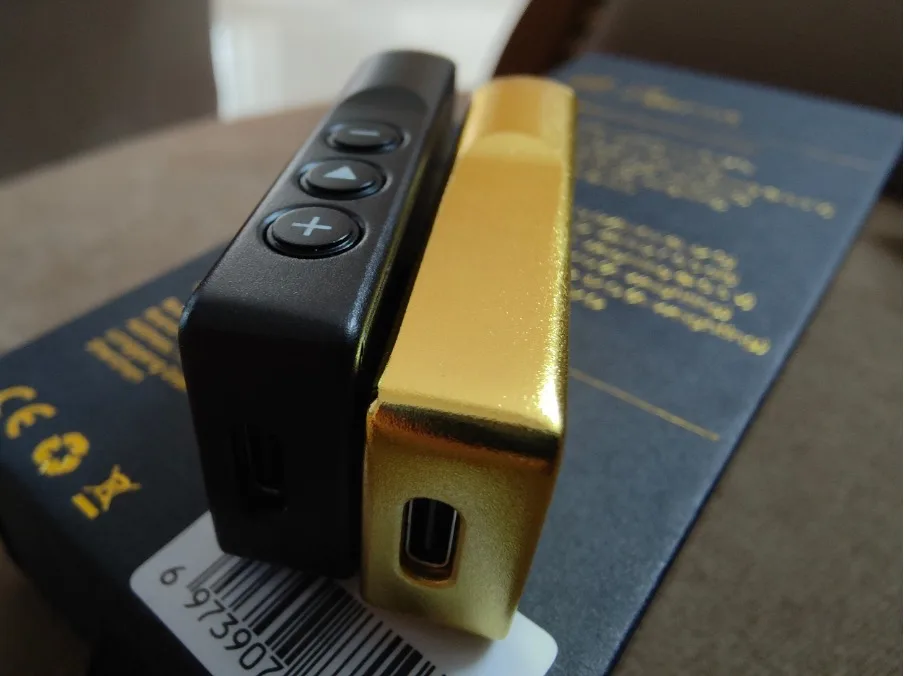Introduction
A few months back, we at Audiomonsta had the chance to review a new hidden gem earphone from a brand that is rarely mentioned, the EPZ Q5 and they actually surprised me with their amazing musicality and technicalities that surpasses their asking price. What always intrigued me when I was browsing their products is their black and gold brick dongle as they look rather tempting on paper while having an interesting design along with a friendly price, and well, the day has come for us to get a chance to review the aforementioned dongles from EPZ, the TP20 and TP30. A big thanks to Willy from Stars Picker Audio Library 摘星知音 for the opportunity to review these beauties and they are the first official distributor for EPZ products here in Malaysia, so do check them out. How will they fare in this ever growing segment of ultra portable DAC/amplifier or dongle? We shall find out here exclusively at Audiomonsta.
Functions & Specifications
Before we start the review, here are the specifications of the TP20 & TP30;
TP20
● Dual Cirrus Logic CS43131
● Zinc alloy body in matte black
● Single crystal mixed copper and silver plated 8 core cable, available in lightning or USB C
Values at high gain
● Output power:3.5mm, 2Vrms@32Ω 125MW@32Ω, 4.4mm, 151mW@32 ohms
● Decoding:PCM 32bit/384KHz/DSD256
● THD+N: 3.5mm, 0.0018% (A-weighting@0.5v) 4.4mm, 0.0008%(A-weighting@0.5v)
● Frequency response:20HZ-40K
● Signal-to-noise ratio: 125DB(3.5mm), 130DB(4.4mm)
● Channel separation:-75DB(3.5mm), -100DB(4.4mm)
● Dynamic range: 125DB(3.5mm), 130DB(4.4mm)
● Output impedance:32Ω
TP30
● Single Sabre ES9038Q2M chipset
● Dual RT6863 Amplifier
● Zinc Alloy Gold-plated Housing
● Interchangeable Digital Input
● Active Clock Crystal Oscillator
● Single crystal mixed copper and silver plated 8 core cable, available in lightning or USB C
Values at high gain
● Output Power: 3.5mm, 2Vrms,125mW @ 32Ω, 4.4m., 4Vrms, 270mW @ 32Ω
● Decoding: up to PCM 32bit/384kHz/DSD256
● THD+N (A-weighting @ 0.5v): 0.0018%(3.5mm), 0.0008%(4.4mm)
● FR Range: 20Hz to 40kHz
● SNR: 125dB(3.5mm), 130dB(4.4mm)
● Channel Separation: -75dB(3.5mm), -100dB(4.4mm)
● Dynamic Range: 125dB(3.5mm), 130dB(4.4mm)
● Output Impedance: 32Ω
Retail Price & Where to Get
The EPZ TP20 & TP30 can be purchased at Starspicker and they are the official distributor for EPZ in Malaysia;
Packaging & Accessories
The EPZ TP20 and TP30 are packaged with the same style of a minimalistic packaging where the TP30 in silver fonts and the TP30 in gold fonts. Both are packaged rather professionally with a simplicity in mind that includes only the cable, manuals and the dongle itself. Buyers can choose the cable to be either USB C or lightning at the same price point. For the low asking price of the product, it is acceptable and also the end product is what matters the most.
The included 8 core cable connectors are gold plated and it does boast a premium quality cable.

Design
The design of both these units here is superb, edgeless with a matte feel and it has some hefty weight to it that might deter some users but I do love it as it gives a solid, premium feel to them. They both weigh 56 grams each and both have a shape design that have similarities with the older Sony WM1 series.
There is a difference between both of these units on how to connect them using my Oppo smartphone, where the TP20 will only turn on with the jacks inserted similar to the Questyle M15 and the TP30 will only operate when you insert the USB C on the phone and then to the unit itself.
TP20
The zinc alloy black brick has a jet black colour with a matte finishing, has a gain selector slider on the side and volume controls along with a play/pause button on the other side. The buttons don’t seem to work with Tidal USB exclusive mode on which is a bummer, but they do work on any other applications or with the exclusive mode turned off.
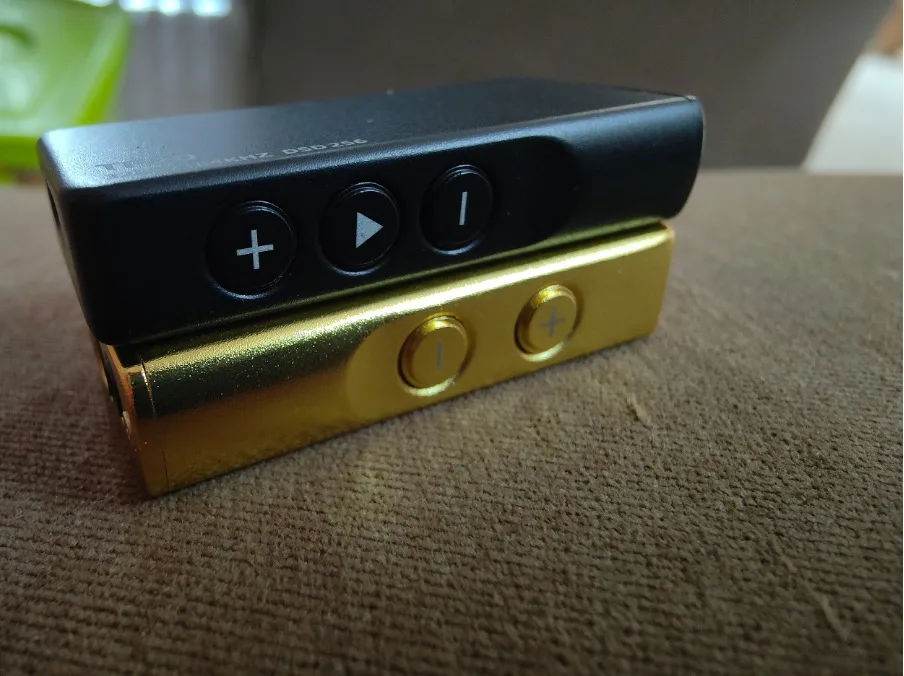
Under the hood we will find 2 sets of Cirrus Logic CS43131 that is quite a popular DAC chip for their smooth neutral sound that is rather good in their overall technicalities for their price.
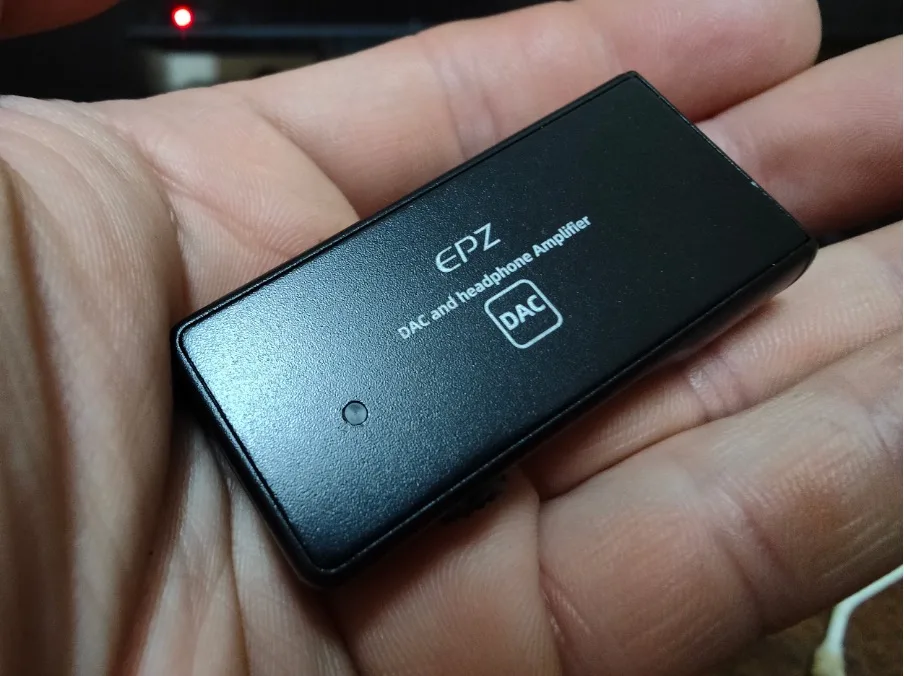
On the top we will have the usual 3.5mm single ended and the 4.4mm balanced with 2 torx screws while on the bottom we will find the standard USB type C input. It has a LED light on the backside to indicate the working mode in green and orange with DAD but it doesn’t display the gain.
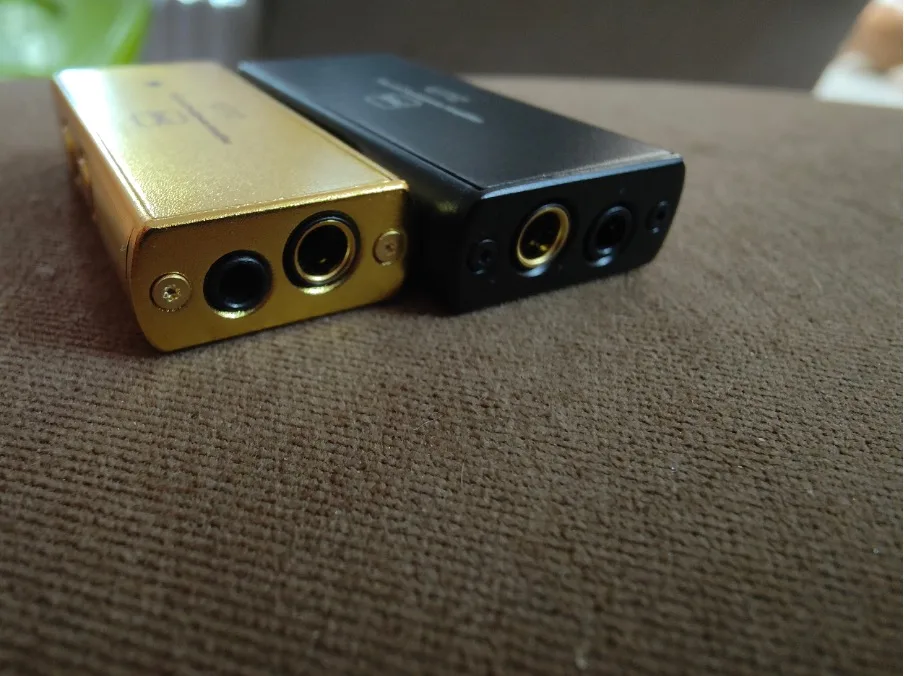
The TP20 is rated at a maximum of 151mv at balanced which is sufficient for most IEMs and some low impedance headphones out there but will not be adequate for low sensitivity headphones like the Sennheiser HD800s or Beyerdynamic T1. They do run slightly warm after a while and there is some battery drain from the source but it is still minimal.
TP30
The gold plated zinc-alloy brick that just oozes a premium aura that surely reminds me of the Sony gold plated DAP, the WM1Z. There are no play/pause buttons, only volume buttons on the side that doubles as a gain selector and to select the gain, users need to push the up and down volume buttons simultaneously. The LED will show blue on high gain and red on low gain.
Inside the TP30 is a single Sabre venerable ES9038Q2M that is famed for their low noise and high dynamic range along with top class technicalities. They are equipped with a crystal clock oscillator that removes the jitter for a more accurate digital to analogue conversion. The amplification here is done by 2 sets of RT6863 Amplifiers that boost their driving power to a maximum 270 mv at balanced and they are indeed more powerful than the TP20 but it still struggles to properly drive low sensitivity headphones.
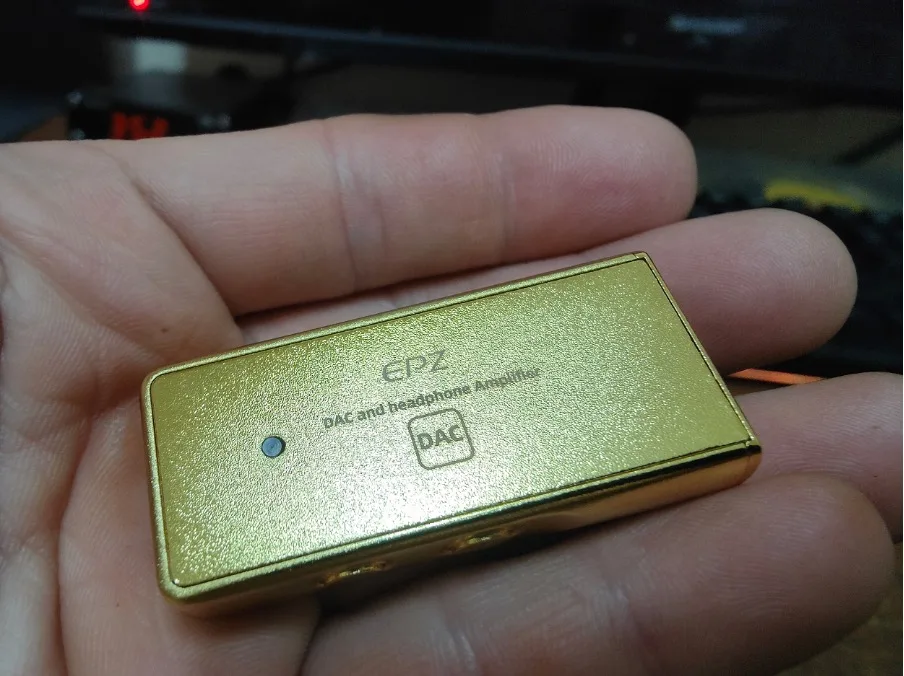
The TP30 might run a warm after long usage but never hot similar to the TP20 but the battery drain is more apparent and might be a problem for long travels. On the top we will have the usual 3.5mm single ended and the 4.4mm balanced with 2 screws also in gold while on the bottom we will find the standard USB type C input. It has a LED light on the backside to indicate the working mode but it doesn’t display the files type.
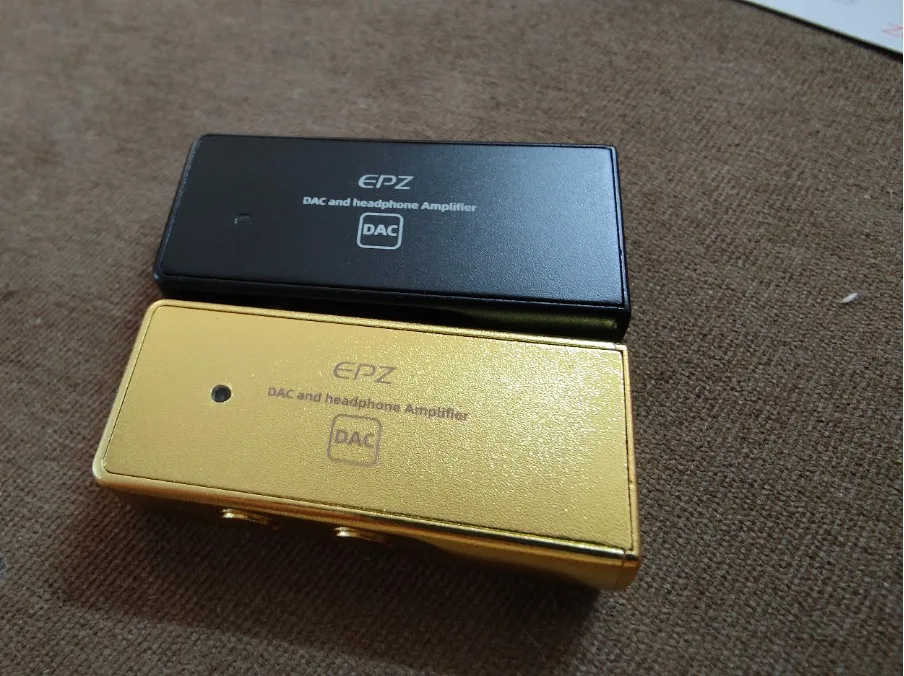
Gears Used for Comparisons
Shanling M6 Ultra
Fiio Q7
Questyle M15
FiiO KA3
Hiby FC6
Hidizs S9PRO
FiiO BTR7
Hidizs MS3
DUNU EST112
Moondrop A8
Ucotech RE1
Hidizs MD4
Blur daBass custom earbud
Toneking TO600s
Sennheiser HD800s
Songs list
Tone and Presentation
TP20
The TP20 staying true to a Cirrus Logic sound, they are a neutral balanced sound with a touch of warmth that has a decent extension in both ends of the frequencies. They do add some brightness into the gears but are still able to sound smooth even when using bright sounding gears. They are great in their resolution and have an adequate, average transparency along with a black background noise which is great.
TP30
The TP30 does bring a trait of a Sabre type of sound that is clean, clear and highly technical with a bright tone that is clinically accurate. The TP30 does tend to focus on the midrange to high range with a neutral flat bass presentation. They do have a minor high range glare that Sabre is known for but it doesn’t sound too harsh or peaky. The bright sound signature may not be suited for bright gears as they may sound somewhat sibilant or too bright. Transparency and resolution here is superb with a good technical performance with a superb low noise floor.
Soundstage
TP20
The soundstage that the TP20 brings is more towards an intimate feel that has decent width but an average height along with a small headroom. They are adequately spacious and have an average amount of air in their overall performance but due to their low retail price, they are acceptable as they do not sound boxy or too closed in.
TP30
The TP30 soundstage here is superb as it gives your gears a good width and height in their overall presentation along with a spacious, airy sound that possesses a medium sized headroom. In terms of their asking price, the TP30 is actually quite competent and manages to hold their value in this area.
Separation and Timbre
TP20
Separation on the TP20 is good with near to none crosstalk happening and it does sound better in this region on the 4.4mm output but on the 3.5mm, layering is a tad bit too close to each other. Timbre here is organic and natural with a slight warm, intimate sound that doesn’t really over emphasise on any of their frequencies. There is some mild coloration in their presentation to bring a more fun sound but it is minimal so it doesn’t interfere much with the accuracy of the sound output.
TP30
Separation here is superb and very well done with wide separation of left and right sound in both outputs. Layering here is great with everything sounding clear without congestion and they are capable of handling fast, complicated tracks with ease. Their timbre here is bright and quite rich sounding that possesses a fast tempo with zero coloration present that gives a true to tone music playback with great accuracy.
Drivability
TP20
The TP20 is rated at a maximum 151 mv per channel which might seem a little low but they are actually quite powerful and certainly more powerful than those basic wired dongles. They have a great volume amount similar to their peers like the Truthear Shio and FiiO KA3 that is sufficient for earphones and earbuds except some planar IEM like the P1 or P2 and enough for portable headphones like my Beyerdynamic T51p along with my Toneking TO600s. For full sized headphones they are drivable but their dynamics are a little constraint and the loudness is barely just enough. The TP20 is actually quite forgiving in their files or bitrate type selection as they sound good at given files or mastered tracks which is good for streaming usage but certainly not for critical listening.
TP30
TP30 on the other hand is rated at a maximum 270 mv per channel which is significantly higher than the TP20 and it does sound a lot stronger and has a wider driving capabilities. They have a driving power that is similar to the Hidizs S9 Pro and slightly behind the Questyle M15. This is partly due to their dual RT6863 amplifier chip that gives some more driving power along with the ES9038Q2M chipset. They are certainly sufficient for IEMs, my 600 ohms earbuds and portable headphones but still aren’t sufficient for low sensitivity full sized headphones in terms of driving power but they do sound loud enough for normal usage. The TP30 is quite choosy when it comes to files selection as they do sound way better on high bitrates files like DSD or lossless and a well mastered track will go a long way for them.
The Bass (Low)
TP20
The bass here present on the TP20 is a neutral balanced bass that is clean and clear with a decent extension that gives a natural, organic representation of bass in music. They have an average detail retrieval here but have a good sense of clarity without any overpowering issue or bleed present. They are suitable for a wider range of gears as they do not add or decrease the amount of bass but instead gives the bass cleaner with a more textured sound and some added clarity. Sub-bass amount remains mostly the same but they do give some extension and air in their presentation with a cleaner rumble. The bass here also does sound a little more intimate than usual but still possesses a good amount of air and this gives a more fun bass response that suits a wider genre.
TP30
The bass here on the TP30 is taking a flatter sound path with a balanced tone that has greater technicalities like better details and they do sound clearer than their counterpart. Details here are amazing with great textured bass sound that is clean and clear along with a tight, punchy bass. They do have a slow roll off bass that gives a better extended bass along with an airier presentation. Due to the flat nature, they actually might tame down some bassy sets and give a little more controlled bass response but on the other hand, with less bassy sets, they might sound a little too plain. Sub-bass has great extension and the rumble it produces does sound clean and clear. The overall bass quality here is actually quite good as they do sound natural and clean but they do lack an energetic sound that gives a more jovial sound but you do get a technically solid bass presentation.
The Mids
TP20
The midrange here has a slightly forward, dense sound that has a mild warmth to it and they are a well balanced neutral midrange. They have a good amount of macro details but a rather average micro details retrieving capabilities. Transparency here is good without any veil present and resolution is great as music is conveyed with a vivid sound that is holographically clean.The TP20 is very well suited for all type ls of vocals due to their balanced, warm tone and there is a touch of brilliance with a lush presentation to make vocals livelier. It is a forward type of midrange with an intimate feel to them and they do lack a spacious sound but they are accurate with their placements with good pinpoint accuracy. There is a mild coloration added here in the mix to give some fun into the midrange and they are certainly enjoyable.
TP30
Midrange on the TP30 here is a neutral type of signature with an emphasis towards the higher region and they are bright. The midrange have a clinical performance that provides a clean and crystal clear sound that has a wider range of sound giving a more breathy timbre to them. Transparency and resolution here is superb as they are clean, clear and vivid at the same time but they do possess some peaks here especially on the mids to high range on higher volumes. Vocals here are great as they do possess a great, shiny brilliance that gives vocals a good decay especially with female vocals but on the other hand, some deep male vocals are slightly lacking in depth. With their spacious midrange, they are a more capable midrange in terms of their genre selection with a good air present that has a mild lushness to them along with a clean, accurate placement of sounds. Coloration here is non-existent and this is typical to a Sabre type of sound as they are a clinical type of midrange that is accurate and clean but they might come off as slightly dry to some.
The Highs
TP20
The high range here is smooth, slightly laid-back and has a neutral approach that is inoffensive but still able to give a lively high range. Details here are great with every nuance of the high range presented in a clear manner and clarity here is good with a full sounding high range. Resolution here is good as they do sound quite vivid in this region but it is not their strength as they tend to sound towards a slightly darker sound. It surely has a smooth high range but they are capable of producing a decent amount of sparkle along with a mild crispiness to their decay that gives music some love to them. Extension here is average but they do give some air into the music and they do not roll off too early which give a good presence in the overall high range. Treble here has a good balance to be a tad bit intense with a good energy but still having a smooth overall sounding treble.
TP30
The TP30 high range is where the focus of this product is and it has a rather nicely tuned Sabre neutral high range that is both strong and very technical with excellent extension along with a great airy presentation. It does have a lift in the 8 to 10 khz region and that makes the TP30 a bright sounding unit that has a superb clinical sound. It is filled with details here as every high range note is presented in a crystal clear manner and it is highly resolving that is typical to a Sabre sound. Though I do find the infamous Sabre glare present, it is acceptable to my ears as the high range isn’t too harsh, peaky nor shouty and sibilance only occurs when the TP30 is paired with bright sounding gears. Sparkle on the high range is simply superb with a sweet decay that gives some bite of energy to the music along with a crisp sound that is highly enjoyable for treble heads. It’s worth noting that due to the overall clinical sound of the high range, the region here will come off as slightly dry in nature but they are accurate and highly technical. Treble here has a healthy dose of intensity that gives a good amount of brilliance and energy for a lively sound but they might incur some fatigue after long usage.
Comparisons
VS FiiO KA3
The KA3 from FiiO China is their offering of a high performance budget dongle that houses a similar Sabre ES9038Q2M chipset that is similar to the TP30 and priced similarly as well. They have an overall bright neutral sound that focuses on the high range with a strong driving lower. Battery drain is similar to the TP30 and slightly more draining than the TP20.
High range
TP20
TP20 high range has a smoother, more relaxed high range that has a more inoffensive sound that is suitable for a long listening while the KA3 sounds more aggressive and brighter with a slightly harsher sound. Details and clarity is better on the KA3 while the TP20 has better extension to their high range.
TP30
Both of these units have a similar bright neutral high range that is energetic and aggressive with similar amount of details and clarity but the TP30 does sound a tad smoother with less shout and harshness. TP30 also does sound crisper and they are more tolerable in their overall strong high range on high volumes.
Midrange
TP20
The midrange on the TP20 has a more dense, warm mids with a better body along with a more intimate sound. The KA3 does have better details and clarity along with a more spacious sound but they are thinner and colder. Resolution here is better on the KA3. Vocals on the KA3 sound more accurate while the TP20 has lusher. Intimate vocals.
Bass
TP20
Bass on TP20 does have the better part of being more full bodied with a bigger slam but details and clarity is slightly better on the KA3. TP20 bass does sound more fun and organic versus the thinner bass of the KA3. Sub-bass on the TP20 has a deeper rumble and extension.
TP30
The bass here is a similar neutral bass with similar amount of details but the TP30 does have a tighter slam along with a better extended bass. Sub-bass on the TP30 does sound a little deeper with a slightly bigger rumble.
Soundstage
TP20
Soundstage on the KA3 is slightly wider and taller with a similar headroom size
TP30
Soundstage on the TP30 does sound wider but the height is the same along with a similar headroom size.
VS Hidizs S9PRO
The legendary S9PRO from Hidizs and they are a powerhouse that is equipped with a single ES9028Q2M and kind of started the hype of ultra portable dongles that possess superb driving capabilities with a neutral flat sound that captivated the globe with their value. They do cost a little more than the TP30 and they are a source power drainer like the TP30 and have the same driving power.
High range
TP20
Highs on the TP20 are stronger and sharper while the S9PRO has a smoother overall sound while still retaining a strong presence. Details and clarity on the S9PRO is slightly better with a more extension at the end. Sparkle on the TP20 is more evident giving a livelier sound.
TP30
Highs here in terms of quantity and quality is surely on the TP30 side as they have more details, clarity and having a superb sparkle along with a crisper sound. Extension and air is also better on the TP30. S9PRO highs are more forgiving as they are smoother overall.
Midrange
TP20
Midrange of the TP20 has a thicker sound with a lusher sound while the S9PRO has a more balanced sound with a good neutrality. Resolution is similar but transparency is better on the S9PRO along with a more spacious mids.
TP30
The TP30 mids does sound brighter with a more vivid sound that is cleaner and clearer. Midrange of the S9PRO does sound more accurate but lacks the energy like the TP30. Resolution is similar but the TP30 is slightly better in their transparency.
Bass
TP20
Bass of the TP20 has a more energetic response along with a deeper, more organic bass versus the flat bass of the S9PRO. Therl mid bass lift on the TP20 does give a more fun, soulful sound but the S9PRO does have better accuracy. Sub-bass has a better extension on the TP20 along with a deeper rumble.
TP30
Bass on the TP30 does sound sharper and tighter along with a slightly better detail retrieval and clarity. Sub-bass is similar with great extension and air.
Soundstage
TP20
Soundstage on the S9PRO is slightly wider and taller with a similar headroom size
TP30
Soundstage on the TP30 sounds a little wider but the height is the same along with a similar headroom size.
Synergy
TP20
For an overall view, the TP20 does has the traits of a Cirrus Logic sound which is a neutral warm sound that is quite balanced overall and will pair well with most types of IEM or headphones but does especially well with bright based gears like the Hidizs MS3, QOA Margarita and even the Duni EST112 as they are capable of giving a smoother high range along with some weight added in the lower region. Synergy with warm based sound is okay but for some too warm sound like the TangZu FuDu, they might come off as being too wet and boring. As for headphones, I do find the TP20 suits open back headphones as they are able to give a more focused sound but do lack airiness in return.
TP30
Being a bright, typical Sabre based sound, the TP30 does very well with warm based sound and even mild bright sets as they do give the sound a lift in their liveliness and energy providing a more enjoyable feel. They also do remedy some gears that lack clarity as the TP30 does give a boost on their transparency and resolution but to a certain extent. Gears like the Moondrop A8, Dunu EST112, Unique Melody 3DT and Dunu Falcon do synergies very well while the Intime Sho DD, MEE P1, Beyerdynamic T51p and BASN Metalen does not pair really well as the high range does get a little hot or peaky with certain genres. As for headphones, I do find them to suit open or closed back dynamic headphones that increase their imaging capabilities and give a cleaner, clearer presentation but on some planars, their treble may get a little too piercing.
Who Is It For?
Both of these EPZ dongles do have a distinct sound profile that will cater to many out there. They are a good starter dongle for users out there with their lower price and amazing driving capabilities all encased in a solid casing. Both of these products do have adequate power for portable gears but insufficient for low sensitivity headphones.
Starting with the TP20, it is more suited for those who want a smooth overall sound that doesn’t skip on their details retrieving abilities. They are overall an inoffensive sound signature that has a slight warmth in their sound and they excel to produce a good overall organic sound. Transparency here is acceptable but they do provide a vivid sound that is holographic and intimate at the same time. There is a good immersive sound here that will suit movies and gaming as well. The TP20 does pair well with most gears but matches particularly well with bright sources to smoothes out the high range. For details, clinical purists out there, the TP30 might be more suited.
The TP30 is a clinical performing wonder as they produce a superb clarity with a clean sound that is a typical Sabre sound. They are indeed a bright source that pushes up the treble to produce a sound that excels in their transparency and gives music a boost in their clarity and spaciousness. The TP30 is a neutral type of signature that doesn’t really over emphasis on the frequencies although strong in their high range, they are also great in their midrange and bass frequency in their performance. Treble sensitive users or pairing with bright sources might want to look elsewhere as the treble intensity might make your gears a little too hot to listen to, causing fatigue. Purists might find this TP30 to perform well as I do find their clinical signature to be rather accurate and technically good.
Final words
EPZ has done it again in my opinion in producing a worthy product that punches above their asking price. Both of these products are super solid in their build and in their performance as well. With 2 types of sound signature catering to a wider audience, they are an easy recommendation. They have superb driving power that suffice for most portable products along with gain and volume controls that gives users more control in their music. Though the controls on android are a little finicky, I do think they will improve with future firmware upgrades. In regards to their sound, both have their pros and cons where the TP20 is more for a casual listening while the TP30 for a brighter, more technical sound, users can select which of these products will suit them best. Overall, EPZ has done a great job here with these two bricks by providing a superb cost to performance ratio index and they do sound impressive to say the least. Well done.
I would rate these 2 products solid 4 and half stars over 5.
Pros TP20;
- Great tone that is slightly warm
- Good resolving capabilities
- Solid build
- Sleek and small
- Easy sound matching
- Slightly warm inoffensive sound
- Good bass and sub-bass quality
- Intimate, lush midrange
- Smooth high range
- Great sparkle with decent brilliance
- Organic timbre
- Powerful sound
- Quiet background
- Full format support
- Price
- Superb quality cable
Cons;
- Micro detailing is average
- May not be clinical enough for critical listeners
- High range isn’t crisp enough
- Lacking transparency
- Midrange a little too intimate, lack space
- Slightly heavy
- Buttons not working in USB exclusive mode (Oppo android)
Pros TP30;
- Highly transparent sound
- Well tuned bright signature
- Solid build, beautiful gold plated body
- Sleek and small
- Good clinical sound
- Controlled dynamics
- Superb technicalities and overall details
- Clean and punchy bass
- Resolving, detailed midrange
- Spacious midrange
- Strong yet highly technical high range with amazing brilliance
- Great sparkle and crisp high range
- Accurate sound
- Superb treble energy
- Powerful sound
- Quiet background
- Great soundstage
- Price
- Superb quality cable
Cons;
- Occasional mild peaks and shout
- Minor ‘Sabre’ glare in high range
- Bright sound might cause fatigue
- Might not suit bright gears
- Slightly thin midrange
- Bass a little lean
- Power drain quite evident
- A little heavy
- Buttons not working in USB exclusive mode (Oppo android)

